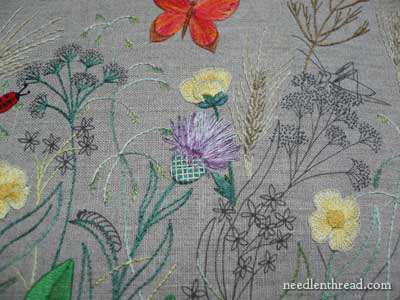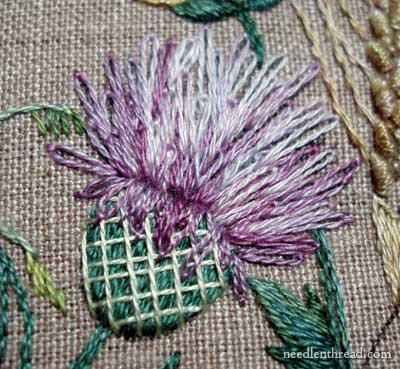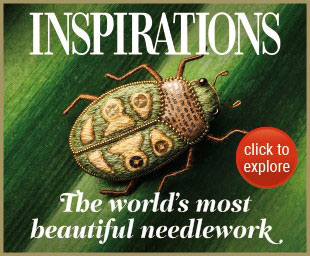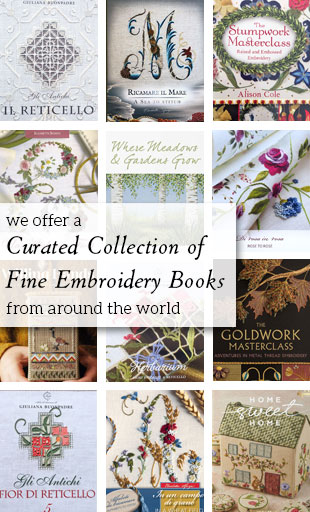I haven’t done much stitching (ok, I haven’t done any stitching) for the past week, but last week, I managed the thistle on the Breath of Spring project I’m working on.
I like the thistle. It’s worked with simple stitches – the base of the flower is long and short stitch in a dark green, crossed with a lattice of light green, and the thistley part of the thistle is stitched in various lengths of daisy stitches.

I like the variegated purple selected for this flower – it ranges from very, very pale, to a medium-dark.

Most of the detached chain stitches that make the head of the thistle shoot upwards, but there’s a little skirt of stitches pointing down, overlapping the base of the flower (is a thistle a flower or a weed?) that add a bit of depth and reality to the look of the flower.
I should have layered my detached chain stitches a little better, starting first with very long ones, and then building shorter ones on top of that. Instead, I worked in a rather random way until I had the head of the thistle filled up. I’m not quite inclined to take the stitches out and do it over, though – overall, I think it looks ok.
One thing I might do over on this is the lattice work. On the pattern, it’s drawn out in very evenly spaced rows, but I think it almost looks too even for such a haphazard, wild looking garden! We’ll see.
So there’s the thistle. Today, I just might tackle that caterpillar….







It is so pretty!!!
Isn’t that a grasshopper??
Could you be suffering from creator-anxiety?
I think that it looks lovely
🙂
I love this thistle, one of my favourite flowers
I’m glad you posted about previous work — we all keep saying ‘get well soon’, but we don’t want you to rush yourself!
We had a big thistle we left to flower by the barn this summer just for the goldfinches to enjoy. Their glorious gold and black plumage with the royal purple flowers were stunning.
Do you think it would be possible to stitch a goldfinch in gold thread?
I like your thistle, it looks properly thistle-y!
Christiana
Properly thistle-y. tee hee! I love that! And I have to agree…it is thistle-y. I think the use of various length daisy stitches to achieve the look is brilliant, and something that I know would never have occured to me to try.
Little wonderful nuggets of info like finding out what stitches were used to create that thistle are one of the things I love about visiting Needle’nThread. Thanks, Mary!
-Jeannine
Hi, Mary–
My daughter, a metalsmith, is in grad school. She’s taking a Medieval Architecture class (this is relevant, so please keep reading!). The prof assigned a research paper, and included some very vague suggestions for ideas. Rachel decided that she would like to investigate Medieval altar linens and paraments. But there seems to be very little information available “out there.” I know, from my background in a liturgical church, that such linens and paraments are often hand-embroidered, and I know that there are “rules” for how the pieces are assembled, folded, stored, what symbols are acceptable, etc. The prof thought this would be ok, provided Rachel build something like a scale model to show how the linens etc. would have been used in a medieval church. She said to Rachel, “Well, you need to research how fabric was made in the Middle Ages, and then how it would drape. Maybe you could actually weave some fabric.” (Never mind that Rachel has never woven anything in her life, and has three other classes besides this one!)
So here’s my question: in your acquisition of a library and other information, as you’ve taught yourself embroidery skills, have you run across any information specifially about Medieval altar linens and/or paraments?
I took a quick look at your links and didn’t see anything at a glance. I’ve found a few books (several of which were in the bibliography on cloth-of-gold in the weaving article about that). Rachel can utilize interlibrary loan for the books–if we can find any. I’m afraid her topic may be too narrow. I’m tempted to suggest that she change to researching cloth-of-gold, which I find fascinating!
Thanks for any advice you may have. And I apologize for the length of this query.
Sue.
My goodness…I am so inspired!!!!
Hope you are feeling a tad better with each new day!
Annie (Michigan)
This thistle looks really neat.I like the effect you got and it came out looking very realistic. Thanks Mary.
-Maria
Hi, all – glad you like the thistle! It was fun. I’ll show you the caterpillar soon – it turned out pretty cute.
Sue – can you e-mail me? Use the “contact us” form at the top of the page. Off the top of my head, the definitive resource on medieval textiles, especially church textiles, is A.G. Christie’s English Medieval Embroidery. It’s a pretty thorough book – I’ve had a chance to browse through it once – but you can only find it in special collections at big city libraries. I had to wear gloves when I looked through it! If you found a copy to purchase under $1,000, it would be a “steal.” Anyway, if you want to contact me via e-mail, I can try to help out with some snippets of information, though I’m no expert!
Thanks,
Mary
The variegated purple looks perfect for the thistle! I’m usually a little wary of variegated threads, but it’s just right.
What a beautiful job Mary…I especially like the grasshopper. He looks like he could jump right off the piece and jump away.As always you are so inspiring!
Bless you,
Annie (Michigan)
Hi Mary, I hope I am not too late to jump in on this one – I have only just found it.
Your thistle looks fantastic, as usual, but since it only a couple of days since I read your bit on fluffing out Ghiordes or Turkish stitch, I have to ask whether you have considered that it might also be a good stitch for the thistle flower?
Also, imho a weed is a plant – any plant – in the wrong place at the wrong time. This is my own definition developed over many years of dealing with wayward plants and learning about herbalism.
I tried this, to the inside of a kilt. The lining had ripped so I used your pin as a guide. Pics are on my Insta @missus_w_vintage
Thank you Mary.